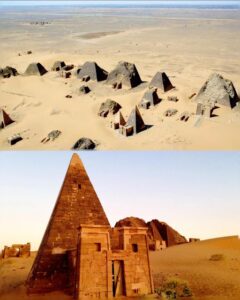Introduction
Deep in the heart of the Sudanese desert lies the ancient city of Meroë, a site steeped in mystery and history. This remarkable city is home to over 200 pyramids, built by the Kingdom of Kush, which flourished from around 800 BCE to 350 CE. Despite its historical significance, Meroë remains lesser-known compared to its more famous Egyptian counterparts. However, its unique structures and rich cultural heritage offer valuable insights into an ancient civilization that continues to captivate researchers.

Architecture and Pyramid Structures
The pyramids of Meroë are distinctive in their design, being smaller and steeper than those of Egypt. Their unique architectural style, characterized by sharp angles and narrow bases, challenges traditional notions of pyramid construction. Researchers are still perplexed by the arrangement of these structures, which does not follow a singular pattern, suggesting a complexity in their design and purpose that merits further investigation. The sheer number of pyramids—over 200—indicates that Meroë was a significant center of power and burial practices, revealing the importance of the afterlife in Kushite culture.

Astronomical Knowledge and Symbolism
Intriguingly, the carvings and symbols found in and around Meroë suggest that the Kushites possessed advanced knowledge of astronomy. Some of these symbols appear to align with celestial events, indicating that the inhabitants may have observed and recorded astronomical phenomena. This knowledge could have played a role in their agricultural practices, religious ceremonies, and the design of their pyramids, underscoring the sophisticated understanding of their environment that the Kushites had. The potential ceremonial functions of the pyramids, along with their role as burial sites, further highlight the complexity of Kushite society and its relationship with the cosmos.
Cultural and Economic Significance
Meroë was not only a burial site but also a thriving cultural and commercial hub. Its strategic location along trade routes facilitated exchanges with neighboring regions, allowing it to flourish as a center of trade. Archaeological findings, including pottery, jewelry, and tools, provide evidence of a wealthy society engaged in various crafts and trades. Moreover, Meroë is recognized as one of the earliest centers of iron production in Africa, illustrating the technological advancements of the Kushites. This innovation not only reflects their ingenuity but also their ability to influence and interact with other civilizations across the continent.

Challenges and Preservation Efforts
Unfortunately, much of Meroë’s rich history was lost due to the actions of treasure hunters in the 19th century, who ravaged the site in search of valuable artifacts. This loss has left historians and archaeologists with more questions than answers, as they work to piece together the narrative of this ancient civilization. Today, Meroë faces new challenges, including climate change and increasing mining activities that threaten its preservation. As such, there is a growing need for efforts to protect and study this significant archaeological site, which not only holds great importance for the history of Sudan but also contributes to a broader understanding of ancient civilizations worldwide.
Conclusion
The pyramids of Meroë, while overshadowed by their Egyptian counterparts, are a testament to the sophistication and cultural richness of the Kingdom of Kush. As we continue to explore and uncover the mysteries of Meroë, we gain valuable insights into a civilization that has shaped the history of Africa. By investing in preservation efforts and conducting further research, we can ensure that the stories of Meroë and its people are not lost to time but celebrated as part of our shared human heritage.
